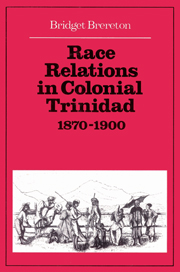Book contents
- Frontmatter
- Contents
- Acknowledgements
- Glossary
- 1 Introduction
- 2 The environment
- 3 The white elite
- 4 Education and mobility
- 5 The rise of a coloured and black middle class
- 6 The urban labouring population
- 7 The black rural masses
- 8 The souls of black folk
- 9 The Indians
- 10 Racism and race relations: the divided society
- Abbreviations
- Notes
- Bibliography
- Index
5 - The rise of a coloured and black middle class
Published online by Cambridge University Press: 08 October 2009
- Frontmatter
- Contents
- Acknowledgements
- Glossary
- 1 Introduction
- 2 The environment
- 3 The white elite
- 4 Education and mobility
- 5 The rise of a coloured and black middle class
- 6 The urban labouring population
- 7 The black rural masses
- 8 The souls of black folk
- 9 The Indians
- 10 Racism and race relations: the divided society
- Abbreviations
- Notes
- Bibliography
- Index
Summary
It was the system of public education which offered the main chance for mobility to coloured and black families of humble origin. But not all members of the non-white middle class in this period can be called ‘self-made’, in the sense of rising to middle-class status through education or exceptional ability. For the coloured and black middle class consisted of two distinct groups. There was a small group of families of mixed African and European descent who were the descendants of the French free people of colour settled in Trinidad since the 1780s. Secondly, there were the people, both black and coloured, who can be described as ‘self-made’. They were the descendants of the Trinidad ex-slaves, or of ‘liberated’ African immigrants, or of immigrants from the eastern Caribbean. And they had acquired their middle-class status mainly through their command of British culture and their white-collar jobs.
The group of French free coloured origin, small in number, formed a quite distinct and self-contained sector. They were concentrated in the Naparima district, and in San Fernando, for it had been here that the majority of the free coloured immigrants had established their plantations after 1783. Like the white French Creoles, they cherished the past. Some of the free coloured settlers had been men of wealth and position; many had been planters and slave-owners. There was the same nostalgic feeling for aristocratic traditions and the same respect for birth and breeding. P. G. L. Borde, the French Creole historian, stated that the customs and manners of the white French Creoles were shared by the free coloureds of French origin who settled in Trinidad.
- Type
- Chapter
- Information
- Race Relations in Colonial Trinidad 1870–1900 , pp. 86 - 109Publisher: Cambridge University PressPrint publication year: 1980



